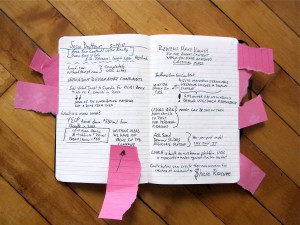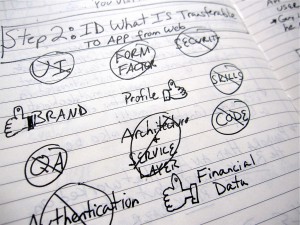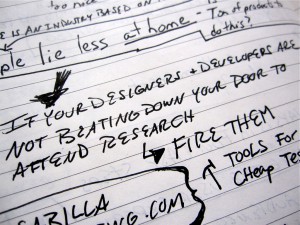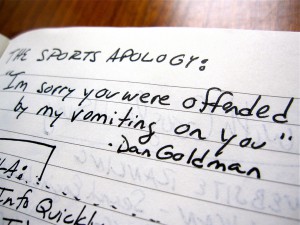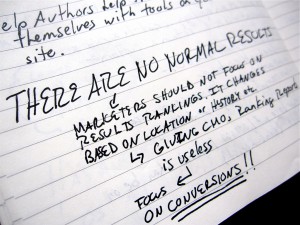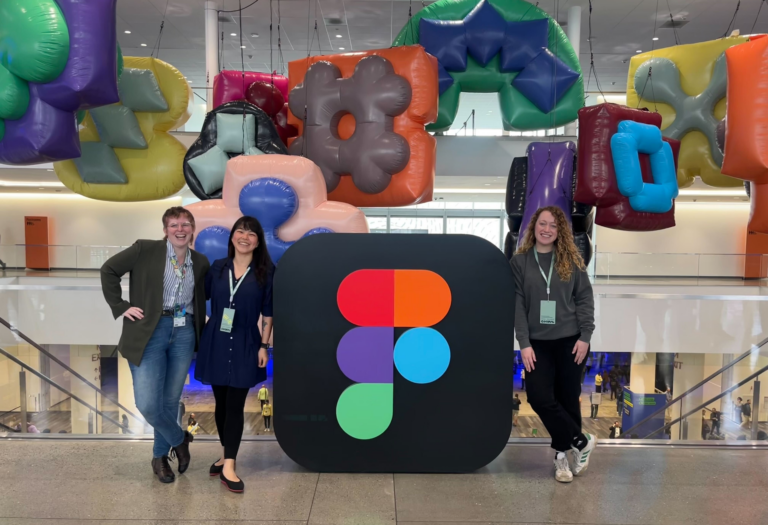Phil’s SXSW Interactive Recap
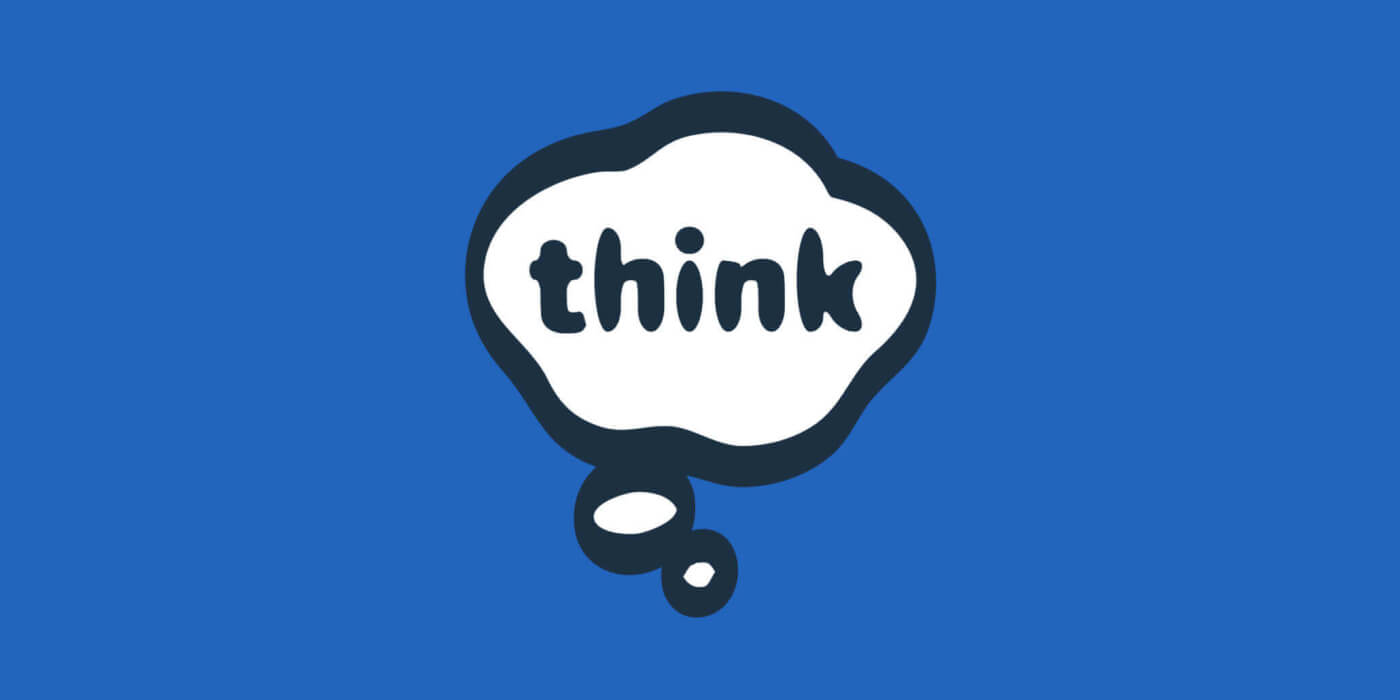
OK, it’s a few weeks after SXSW Interactive closed. While Russ and I posted our misgivings about the setup and execution of SXSW, we were able to find a ton of sessions and there was a lot of value to be absorbed. To see our sketch notes, click the image below.
Cooperative Gaming
Buster Benson, healthmonth.com
Thor Muller, Get Satisfaction, Inc.
As I noted in my off-the-cuff review here, Buster and Thor practiced what they preach in this session. After over a decade in the learning design industry, I’m always glad to see something new and different, and Buster and Thor served it up.
Conference Presenter Tip #1: Don’t just talk, DO SOMETHING
From Web to Mobile Apps
Aaron Forth, mint.com and Intuit
Aaron spoke about their journey from the web to their mobile app. He highlighted three main steps that any experience designer would say, “duh” to, but I bet most don’t follow when the rubber hits the road: 1. Pick your platform 2. Identify what is transferrable from the web to your app 3. Concentrate on the user’s experience
Stop Listening to Your Customers
Mark Trammell, Twitter
Nate Bolt, Bolt/Peters
This session covered alternative methods for user testing and customer research. Twitter isn’t making a profit yet, so their testing budgets are tiny, but they have successfully redesigned and launched their site and app through multiple versions. How did they do this? Watching behavior of existing users, combining inexpensive tools like silverlight, and rapid prototype/test cycles. This is where I heard the best line of the conference:
Patients and Caregivers on Facebook: Establishing Boundaries without Barriers:
Dana Lewis, Swedish Health Services
Daniel Goldman, Mayo Clinic
Ed Bennett, University of Michigan
Keely Kolmes, Ohio State
Jennifer Dyer, Psychotherapist
This was one of many of the health track sessions I attended. This session focused on ethical ways caregivers can engage electronically with their patients while still protecting themselves. The highlight of the session was the participation of Daniel Goldman, the intellectual property attorney for Mayo Health Clinic. It’s no mystery that Mayo is one of the most digitally engaged healthcare facilities in the nation. Clearly, the progressive perspective of Goldman has contributed a lot to that. Some advice Goldman gives physicians who are concerned about getting involved online: “The riskiest thing a doctor does is practice medicine.” He uses this to set the stage, not to encourage doctors to dive into the shallow end.
Social Media in Regulated Industries
Shannon Paul, Blue Cross Michigan
Shwen Gwee, Vertex Pharmaceuticals
Marc Monseau, Johnson and Johnson
The panelists answered questions from the crowd on how to engage digital audiences when your organization operates under government regulations. These folks know their stuff. Attendees covered a range of industries from tobacco to law enforcement to pharmaceuticals and the military. We barraged them with questions for an entire hour, then pulled them out into the hallway to continue the conversation while SXSW prepped the room for the next session.
Conference Presenter Tip #2: Q&A is valuable. People want to ask experts how they do what they do. Make sure they are experts.
Online Health Communities
Jenni Prokopy, chronicbabe.com
Jenni demonstrated how online health communities rock, how they struggle and why they are necessary. Jenni is a pioneer in online health communities and a good friend of Think Brownstone. A patient herself, Jenni and all online health community volunteers are an inspiration. They provide support for large communities of patients, often without much credit or compensation. The Q&A session was great. See Conference Presenter Tip #2 above.
Free Your Content! Who Really Owns Your Online User-Generated Content
J.J. Johnson, founder Virtual Tourist and Lunch.com
J.J. discussed different UGC ownership models. As most of us know, you usually own your own content when you participate on a UGC site and some organizations are exploring sharing revenue with their most prolific contributors. J.J. discussed how his organizations have explored those revenue models. This was one of those gems of the conference that was, unfortunately, sequestered a mile away at another hotel.
The Legal Ramifications of Saying “I’m Sorry”
Chris Moran, Consumerist
Fred Taylor, Southwest Airlines
Margaret DiBianca, attorney
Paula Berg, PR consultant
This panel session brought together a collection of experts to discuss the ramifications of organizations saying “I’m Sorry” online. This panel was another lively Q&A, session. Two great highlights: Dan Goldman describing the dreaded sports apology as, “I’m sorry you were offended by my vomiting on you” and Fred Taylor discussing Southwest’s unique formula for an apology: Level with the customer. Show you are engaged with their issue. Acknowledge what they went through.
Q&A with Google and Bing
Danny Sullivan, Search Engine Land
Matt Cutts, Google
Duane Forrester, Bing
This was easily the most crowded session I attended. This was the ultimate SEO geekfest with Matt and Duane answering any question the audience could throw at them. The session was standing room only and the audience asked questions ranging from simple to expert. Their advice can be summarized pretty simply and has been the SEO mantra for years: Create valuable, unique content and use Webmaster tools. This was an extremely valuable session. See Conference Presenter Tip #2 above.
Abolishing the Hourly Rate
John Lax
Lee Dale
John and Lee led a session specifically for agencies on how to abolish hourly rate pricing and embrace value pricing. These guys had enough guts to base the business models of their two agencies entirely on value pricing. For those of you who have worked in agencies, you’ll be surprised to hear they don’t use timesheets. If you are interested in this topic, they recommended Ron Becker’s book and Tim Williams blog.
Ideas not Objects
Robert Brunner, Ammunition Group
An icon in the industrial design community, Robert walked us through some of the highlights of his career. His joked that his claim-to-fame at Apple was that he hired Johnny Ive. One of the most impressive moves he made, actually, was his redesign of the failed Macintosh Portable into the Powerbook series. This series set the standard for laptop design you know today whether you’re on a Mac, Dell, Lenovo, Toshiba or other laptop.

